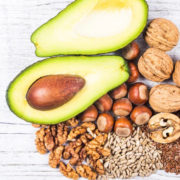An allergic reaction occurs when the body’s immune system overreacts to an allergen.A food allergy is an immune-mediated adverse reaction to a particular food. For someone with a food allergy, eating or swallowing even a tiny amount of a particular food can cause symptoms such as skin rash, nausea, vomiting, cramping, and diarrhea.
Reaction is often called a hypersensitivity reaction. Rarely, a severe allergic reaction can cause a life-threatening set of symptoms called anaphylaxis, or anaphylactic shock.
Although a large percentage of people believe they have a food allergy, few adults and children, mainly younger than 6 years, have true food allergies [MORE THAN ONE IN TEN U.S. ADULTS HAS FOOD ALLERGY]. The rest have what is known as food intolerance, an undesirable reaction to a food that does not involve the immune system.
It is easy to confuse food intolerance with food allergy because they can have similar symptoms. With food intolerance, however, a person usually gets only mild symptoms such as an upset stomach.
Foods That Cause Allergies
The only way to prevent an allergic reaction to a food is to avoid that food. If you are allergic read labels carefully and when in restaurants ask about ingredients in the food you order.
Hare are some most common foods that causes allergies.
Milk (mostly in children)
Eggs
Peanuts
Tree nuts (like walnuts and pecans)
Soy
Wheat
Common Food Allergy Symptoms
When the body has an immune system reaction to a specific food, it produces antibodies to that food. When you eat that food, an immune response is triggered, your body releases histamines and you have allergic symptoms. These symptoms may occur immediately after eating the specific food, or up to hours later. Food allergy symptoms may include:
skin rash
hives
swelling of the tongue or throat
breathing problems including asthma
vomiting or diarrhea
abdominal pain
In severe cases, the allergic reaction may result in a drop-in blood pressure, loss of consciousness, or death.
When to see a Doctor?
Visit your local emergency room if:
you experience hives or swollen lips or tongue along with difficulty breathing
experience changes in consciousness after eating
two or more of hives, swollen lips, low blood pressure (which may make you feel woozy or cause changes in heart rate when sitting upright or standing), or abdominal symptoms (vomiting, severe nausea, or diarrhea) after eating
have an asthma attack after eating that doesn’t respond to your normal rescue medication, especially if you are also experiencing skin symptoms or swelling
These symptoms can indicate a severe allergic reaction called anaphylaxis.
Anaphylaxis is a serious, life-threatening allergic reaction. The most common anaphylactic reactions are to foods, insect stings, medications and latex. If you are allergic to a substance, your immune system overreacts to this allergen by releasing chemicals that cause allergy symptoms. The reaction can occur within seconds or minutes of exposure to an allergen.
Symptoms
Include a skin rash, nausea, vomiting, difficulty breathing (asthma attacks) and shock. Severe asthma attacks also require immediate attention from a medical professional if they do not respond to rescue medication.














